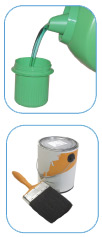
Clean Living
By on Jun 25, 2008

Most Canadians are aware of the health
risks posed by chemical toxins in the
workplace. However, many of us may notknow of the risks posed by long-term exposure to chemicals in the place where we spend most of our time: our homes.
In the vast majority of cases, the best way to reduce levels of chemical contaminants is to prevent them
from entering your environment in the first place. To keep your house as chemical-free as possible, thoroughly screen all substances you bring into your
home and carefully select building materials if you're building or renovating.
To identify potential sources of toxins, take an inventory of the products and materials that you use
and avoid or minimize those known to give off
chemical emissions (also called off-gassing).Unfortunately, only a few products-such as glass,
ceramic tile, metal, stone, and other hard, inertmaterials-do not release emissions. To find out what
other products may emit chemicals, look at literatureor websites that provide reliable information
about specific products or consult with qualifiedexperts who are trained to understand the materials
you're using.
The most common sources of off-gassing are the
chemicals used to clean around the home, including
solutions, floor wax, stain removers, air fresheners,scented soaps and detergents, fragrant fabric softeners,
and personal cosmetics. Using these substances canresult in continuous exposure to chemicals, so if you or
your family experiences any adverse reactions, switch tounscented or non-toxic cleaners.
Another source of chemical emissions are products
that you use frequently and in large quantities, suchas building materials. In general, substances such
as paint, varnish, and glue will release emissions atthe beginning and decline over time to low or
non-detectable levels. Materials that are subject tohigh temperatures (such as a carpet laid over
a heated floor) or high moisture levels (likeparticleboard furniture kept in a humid spot) can also
be significant sources of chemical emissions.

Unless you have an impaired sense of smell, you
can often use your nose as a guide. But remember
that while an odour can indicate the presence ofemissions, the absence of odour doesn't necessarily
rule out the possibility of chemical contaminants.The concentration of the chemical contaminants may simply
be lower than what you can detect or they may haveno discernable odour, such as with carbon monoxide,
carbon dioxide, and radon.
Occasionally, poor indoor air quality comes from
unexpected sources. For example, strong, unpleasant
odours have been traced to overheated plastic socketsin light bulbs receptacles, so never use a higher
wattage bulb than recommended and note that somelight fixtures may require a ceramic socket.
To reduce kitchen odours, take proper care of your
garbage or compost container, including rinsing anymeat packaging before tossing it into the trash and
keeping perishables in the freezer until garbage day.Always turn on the range hood while cooking. In the bathroom, use the exhaust
fan to remove moisture andresidual odours.
If you notice that the
air quality in your homedeteriorates suddenly,
examine any items you'vebrought into the house
recently. If you thinkyou've identified the
culprit, isolate the itemin another room or
encapsulate it temporarilywith polyethylene. Then
note whether removing theitem helped clear the air.
For more information or
for a free copy of CMHC'sfact sheets How to Reduce
Chemical Contaminants in Your Home and How toRead a Material Safety Data Sheet, contact CMHC at
www.cmhc.ca or 1?800-668-2642.
Mark Salerno is district manager for the GTA at the
Canada Mortgage and Housing Corporation. For
housing agency and a source of objective, reliable


